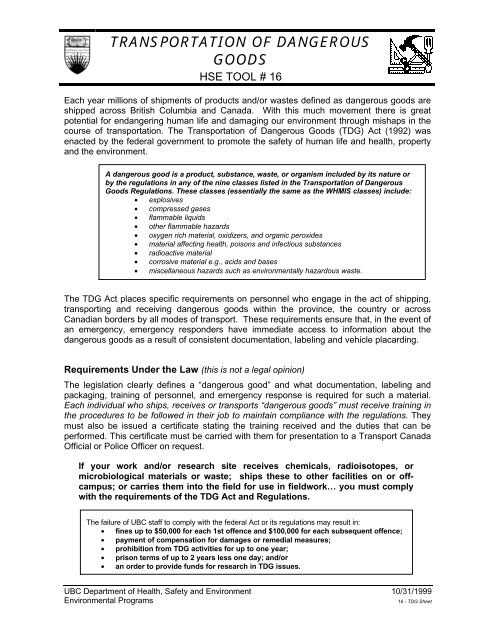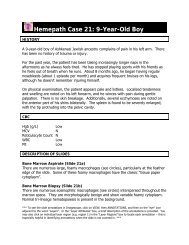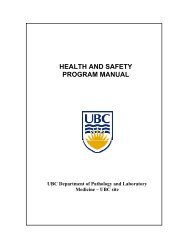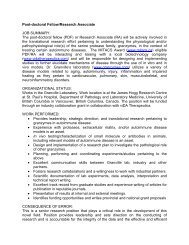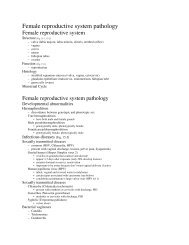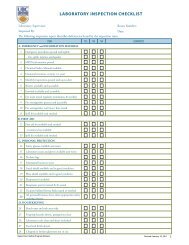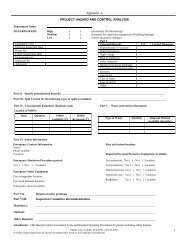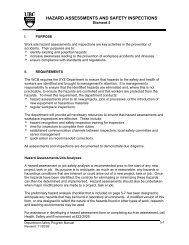transportation of dangerous goods - Pathology and Laboratory ...
transportation of dangerous goods - Pathology and Laboratory ...
transportation of dangerous goods - Pathology and Laboratory ...
Create successful ePaper yourself
Turn your PDF publications into a flip-book with our unique Google optimized e-Paper software.
TRANSPORTATION OF DANGEROUSGOODSHSE TOOL # 16Each year millions <strong>of</strong> shipments <strong>of</strong> products <strong>and</strong>/or wastes defined as <strong>dangerous</strong> <strong>goods</strong> areshipped across British Columbia <strong>and</strong> Canada. With this much movement there is greatpotential for endangering human life <strong>and</strong> damaging our environment through mishaps in thecourse <strong>of</strong> <strong>transportation</strong>. The Transportation <strong>of</strong> Dangerous Goods (TDG) Act (1992) wasenacted by the federal government to promote the safety <strong>of</strong> human life <strong>and</strong> health, property<strong>and</strong> the environment.A <strong>dangerous</strong> good is a product, substance, waste, or organism included by its nature orby the regulations in any <strong>of</strong> the nine classes listed in the Transportation <strong>of</strong> DangerousGoods Regulations. These classes (essentially the same as the WHMIS classes) include:• explosives• compressed gases• flammable liquids• other flammable hazards• oxygen rich material, oxidizers, <strong>and</strong> organic peroxides• material affecting health, poisons <strong>and</strong> infectious substances• radioactive material• corrosive material e.g., acids <strong>and</strong> bases• miscellaneous hazards such as environmentally hazardous waste.The TDG Act places specific requirements on personnel who engage in the act <strong>of</strong> shipping,transporting <strong>and</strong> receiving <strong>dangerous</strong> <strong>goods</strong> within the province, the country or acrossCanadian borders by all modes <strong>of</strong> transport. These requirements ensure that, in the event <strong>of</strong>an emergency, emergency responders have immediate access to information about the<strong>dangerous</strong> <strong>goods</strong> as a result <strong>of</strong> consistent documentation, labeling <strong>and</strong> vehicle placarding.Requirements Under the Law (this is not a legal opinion)The legislation clearly defines a “<strong>dangerous</strong> good” <strong>and</strong> what documentation, labeling <strong>and</strong>packaging, training <strong>of</strong> personnel, <strong>and</strong> emergency response is required for such a material.Each individual who ships, receives or transports “<strong>dangerous</strong> <strong>goods</strong>” must receive training inthe procedures to be followed in their job to maintain compliance with the regulations. Theymust also be issued a certificate stating the training received <strong>and</strong> the duties that can beperformed. This certificate must be carried with them for presentation to a Transport CanadaOfficial or Police Officer on request.If your work <strong>and</strong>/or research site receives chemicals, radioisotopes, ormicrobiological materials or waste; ships these to other facilities on or <strong>of</strong>fcampus;or carries them into the field for use in fieldwork… you must complywith the requirements <strong>of</strong> the TDG Act <strong>and</strong> Regulations.The failure <strong>of</strong> UBC staff to comply with the federal Act or its regulations may result in:• fines up to $50,000 for each 1st <strong>of</strong>fence <strong>and</strong> $100,000 for each subsequent <strong>of</strong>fence;• payment <strong>of</strong> compensation for damages or remedial measures;• prohibition from TDG activities for up to one year;• prison terms <strong>of</strong> up to 2 years less one day; <strong>and</strong>/or• an order to provide funds for research in TDG issues.UBC Department <strong>of</strong> Health, Safety <strong>and</strong> Environment 10/31/1999Environmental Programs16 - TDG Sheet
TRANSPORTATION OF DANGEROUSGOODSHSE TOOL # 16You know that a material is a <strong>dangerous</strong> good:• if it is a WHMIS-controlled product (usually),• if the supplier states that it is, or it is indicated on the MSDS, or• if it is in Schedule II <strong>of</strong> the TDG Regulations.You may also contact the HSE Chemical Safety Officer (822-5909) for confirmation <strong>of</strong> TDGstatus <strong>of</strong> a material.IF you transport <strong>dangerous</strong> <strong>goods</strong> for work or research ON-CAMPUS you must:• ensure (at a minimum) that− the materials are labeled properly,− you are aware <strong>of</strong> the hazards associated with the material,− you have outer packaging to prevent an accidental release or spill, <strong>and</strong>− you know what to do in the case <strong>of</strong> a spill.• contact the Chemical Safety Officer first if you are planning to use a vehicle for oncampustransport <strong>of</strong> <strong>dangerous</strong> <strong>goods</strong>,• contact the Chemical Safety Officer (822-5909) for information <strong>and</strong> training for anyonewho routinely transports <strong>dangerous</strong> <strong>goods</strong> on campus or departments that are movinglaboratory sites.To re-use boxes that have been used for shipping <strong>dangerous</strong> <strong>goods</strong> (i.e., have TDGlabels):you must deface or remove all TDG labels on the outside <strong>of</strong> the box. It is illegal to transportmaterials with misleading safety marks <strong>and</strong> labels under the TDG Act.If you have been certified <strong>and</strong> trained in TDG by another employer:you must be recertified by UBC, because certification <strong>and</strong> training in TDG is employerspecificunder the regulations. In addition, you must be re-certified by UBC every three (3)years for transport <strong>of</strong> <strong>dangerous</strong> <strong>goods</strong> by road <strong>and</strong> every year for transport by air.If you transport waste materials for your research or work:[except domestic garbage, which is exempted from the TDG regulations] you should contactthe HSE Chemical Safety Officer (822-5909) to confirm what is required. If you transport lessthan 5kg <strong>of</strong> solid waste or 5L <strong>of</strong> liquid waste, you may also be exempted from the TDGregulations.If <strong>of</strong>fice staff receive chemicals or other hazardous materials for your lab or work site:<strong>of</strong>fice staff who receive boxes <strong>of</strong> chemicals from suppliers or couriers must be trained in theTDG Receivers' Course <strong>of</strong>fered by HSE.Health, Safety <strong>and</strong> Environment is working to ensure UBC personnel <strong>and</strong> facilities complywith the TDG regulations. The Chemical Safety Officer may be contacted for moreinformation about TDG training, <strong>and</strong> other TDG questions may be addressed to the HSE<strong>of</strong>fice at 822-2029.UBC Department <strong>of</strong> Health, Safety <strong>and</strong> Environment 10/31/1999Environmental Programs16 - TDG Sheet


